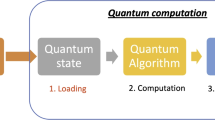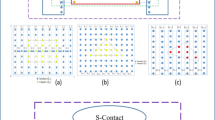Abstract
We propose a new formulation of the Wigner transport equation (WTE) with infinite correlation length. Since the maximum correlation length is not limited to a finite value, there is no uncertainty in the simulation results owing to the finite integral range of the nonlocal potential term. For general and efficient simulation, the proposed WTE formulation is solved self-consistently with the Poisson equation through the finite volume method and the fully coupled Newton–Raphson scheme. Through this, we implemented a quantum transport steady state and transient simulator with excellent convergence.


















Similar content being viewed by others
Data availability
The data that support the findings of this study are available from the corresponding author upon reasonable request.
References
Jin, S., Tang, T., Fischetti, M.V.: Simulation of silicon nanowire transistors using Boltzmann transport equation under relaxation time approximation. IEEE Trans. Electron Devices 55(3), 727–736 (2008). https://doi.org/10.1109/TED.2007.913560
Hong, S.-M., Jungemann, C.: A fully coupled scheme for a Boltzmann–Poisson equation solver based on a spherical harmonics expansion. J. Comput. Electron. 8, 225–241 (2009). https://doi.org/10.1007/s10825-009-0294-y
Cha, S., Hong, S.-M.: Theoretical study of electron transport properties in GaN-based HEMTs using a deterministic multi-subband Boltzmann transport equation solver. IEEE Trans. Electron Devices 66(9), 3740–3747 (2019). https://doi.org/10.1109/TED.2019.2926857
Jungemann, C., Pham, A.T., Meinerzhagen, B., Ringhofer, C., Bollhofer, M.: Stable discretization of the Boltzmann equation based on spherical harmonics, box integration, and a maximum entropy dissipation principle. J. Appl. Phys. (2006). https://doi.org/10.1063/1.2212207
Wang, J., Lundstrom, M.: Does source-to-drain tunneling limit the ultimate scaling of MOSFETs? In: Digest. International Electron Devices Meeting, pp. 707–710 (2002). https://doi.org/10.1109/IEDM.2002.1175936.
Yadav, D., Nair, D.R.: Impact of source to drain tunneling on the ballistic performance of Si, Ge, GaSb, and GeSn nanowire p-MOSFETs. IEEE J. Electron. Devices Soc. 8, 308–315 (2020). https://doi.org/10.1109/JEDS.2020.2980633
Kao, K.-H., Wu, T.R., Chen, H.-L., Lee, W.-J., Chen, N.-Y., Ma, W.C.-Y., Su, C.-J., Lee, Y.-J.: Subthreshold swing saturation of nanoscale MOSFETs due to source-to-drain tunneling at cryogenic temperatures. IEEE Electron. Device Lett. 41(9), 1296–1299 (2020). https://doi.org/10.1109/LED.2020.3012033
Kadanoff, L.P., Baym, G.: Quantum Statistical Mechanics, p. 1962. Benjamin, New York (1962). https://doi.org/10.1201/9780429493218
Wigner, E.: On the quantum correction for thermodynamic equilibrium. Phys. Rev. 40, 749 (1932). https://doi.org/10.1103/PhysRev.40.749
Frensley, W.R.: Boundary conditions for open quantum systems driven far from equilibrium. Rev. Modern Phys. 63, 215 (1990). https://doi.org/10.1103/RevModPhys.62.745
Fischetti, M.V.: Theory of electron transport in small semiconductor devices using the Pauli master equation. J. Appl. Phys. 83, 270 (1998). https://doi.org/10.1063/1.367149
Fischetti, M.V.: Master-equation approach to the study of electronic transport in small semiconductor devices. Phys. Rev. B 59, 4901 (1999). https://doi.org/10.1103/PhysRevB.59.4901
Stettler, M.A., et al.: Industrial TCAD: modeling atoms to chips. IEEE Trans. Electron Devices 68(11), 5350–5357 (2021). https://doi.org/10.1109/TED.2021.3076976
Mahdi, P.: Numerical study of quantum transport in carbon nanotube-based transistors. dissertation, Institute for Microelectronics, Vienna University of Technology, Vienna (2007)
Jin, S., Park, Y.J., Min, H.S.: A three-dimensional simulation of quantum transport in silicon nanowire transistor in the presence of electron-phonon interactions. J. Appl. Phys. 99, 123719 (2006). https://doi.org/10.1063/1.2206885
Luisier, M., Klimeck, G.: Atomistic full-band simulation of silicon nanowire transistors: effects of electron-phonon scattering. Phys. Rev. B 80, 155430 (2009). https://doi.org/10.1103/PhysRevB.80.155430
Gunst, T., Markussen, T., Palsgaard, M.L., Stokbro, K., Brandbyge, M.: First-principles electron transport with phonon coupling: large scale at low cost. Phys. Rev. B 96, 161404 (2017). https://doi.org/10.1103/PhysRevB.96.161404
Vyas, P.B., Van de Put, M.L., Fischetti, M.V.: Master-equation study of quantum transport in realistic semiconductor devices including electron-phonon and surface-roughness scattering. Phys. Rev. Appl. 13, 014067 (2020). https://doi.org/10.1103/PhysRevApplied.13.014067
Pham, A.-T., Kin, S., Lu, Y., Park, H.-H., Choi, W., Pourghaderi, M.A., Kim, J., Kwon, U., Kim, D.: Simulations of self-heating effects in SiGe pFinFETs based on self-consistent solution of carrier/phonon BTE coupled system. In: 2018 International Conference on Simulation of Semiconductor Processes and Devices (SISPAD), Austin, TX, USA, 2018, pp. 145–148. https://doi.org/10.1109/SISPAD.2018.8551670
Pourghaderi, M.A., Pham, A.-T., Kim, S., Chung, H., Jiang, Z., Ilatikhameneh, H., Park, H.-H., Jin, S., Kim, J., Chung, W.-Y., Kwon, U., Choi, W., Kim, D.S., Maeda, S.: Universal swing factor approach for performance analysis of logic nodes. In: 2018 IEEE International Electron Devices Meeting (IEDM), San Francisco, CA, USA, 2018, pp. 33.3.1–33.3.4, https://doi.org/10.1109/IEDM.2018.8614696
Stanojević, Z., Strof, G., Baumgartner, O., Rzepa G., Karner, M.: Performance and leakage analysis of Si and Ge NWFETs using a combined subband BTE and WKB approach. In: 2020 International Conference on Simulation of Semiconductor Processes and Devices (SISPAD), Kobe, Japan, 2020, pp. 63–66, https://doi.org/10.23919/SISPAD49475.2020.9241614
Stanojević, Z., Tsai, C.-M., Strof, G., Mitterbauer, F., Baumgartner, O., Kernstock, C., Karner, M.: Nano device simulator—a practical subband-BTE solver for path-finding and DTCO. IEEE Trans. Electron Devices 68(11), 5400–5406 (2021). https://doi.org/10.1109/TED.2021.3079884
Hillery, M., O’Connell, R.F., Scully, M.O., Wigner, E.P.: Distribution functions in physics: fundamentals. Phys. Rep. 106(3), 121–167 (1984). https://doi.org/10.1016/0370-1573(84)90160-1
Jacoboni, C., Bordone, P.: The Wigner-function approach to non-equilibrium electron transport. Rep. Prog. Phys. 67, 1033–1071 (2004). https://doi.org/10.1088/0034-4885/67/7/R01
Nedjalkov, M., Vasileska, D., Ferry, D.K., Jacoboni, C., Ringhofer, C., Dimov, I., Palankovski, V.: Wigner transport models of the electron-phonon kinetics in quantum wires. Phys. Rev. B 74, 035311 (2006). https://doi.org/10.1103/PhysRevB.74.035311
Rossi, F., Jacoboni, C., Nedjalkov, M.: A Monte Carlo solution of the Wigner transport equation. Semicond. Sci. Technol. 9, 934 (1994)
Querlioz, D., Saint-Martin, J., Do, V.-N., Bournel, A., Dollfus, P.: A study of quantum transport in end-of-roadmap DG-MOSFETs using a fully self-consistent Wigner Monte Carlo approach. IEEE Trans. Nanotechnol. 5(6), 12 (2006). https://doi.org/10.1109/TNANO.2006.883477
Barraud, S.: “Dissipative quantum transport in silicon nanowires based on Wigner transport equation. J. Appl. Phys. 110(9), 1 (2011). https://doi.org/10.1063/1.3654143
Jiang, H., Cai, W., Tsu, R.: Accuracy of the Frensley inflow boundary condition for Wigner equations in simulating resonant tunneling diodes. J. Comput. Phys. 230(5), 2031–2044 (2011). https://doi.org/10.1016/j.jcp.2010.12.002
Yamada, Y., Tsuchiya, H., Ogawa, M.: Quantum transport simulation of silicon-nanowire transistors based on direct solution approach of the Wigner transport equation. IEEE Trans. Electron. Devices 56(7), 1396–1401 (2009). https://doi.org/10.1109/TED.2009.2021355
Rosati, R., Dolcini, F., Iotti, R.C., Rossi, F.: Wigner-function formalism applied to semiconductor quantum devices: Failure of the conventional boundary condition scheme. Phys. Rev. B 88, 035401 (2013). https://doi.org/10.1103/PhysRevB.88.035401
Hong, S., Jang, J.: Transient simulation of semiconductor devices using a deterministic Boltzmann equation solver. IEEE J. Electron. Devices Soc. 6, 156–163 (2018). https://doi.org/10.1109/JEDS.2017.2780837
Jin, S., Fischetti, M.V., Tang, T.-W.: Theoretical study of carrier transport in silicon nanowire transistors based on the multisubband Boltzmann transport equation. IEEE Trans. Electron. Devices 55(11), 2886–2897 (2008). https://doi.org/10.1109/TED.2008.2005172
Iotti, R.C., Dolcini, F., Rossi, F.: Wigner-function formalism applied to semiconductor quantum devices: Need for nonlocal scattering models. Phys. Rev. B 96, 115420 (2017). https://doi.org/10.1103/PhysRevB.96.115420
Jonasson, O., Karimi, F., Knezevic, I.: Partially coherent electron transport in terahertz quantum cascade lasers based on a Markovian master equation for the density matrix. J. Comput. Electron. 15, 1192–1205 (2016). https://doi.org/10.1007/s10825-016-0869-3
Soleimanikahnoj, S., Jonasson, O., Karimi, F., et al.: Numerically efficient density-matrix technique for modeling electronic transport in mid-infrared quantum cascade lasers. J. Comput. Electron. 20, 280–309 (2021). https://doi.org/10.1007/s10825-020-01627-x
Costolanski, A.S., Kelley, C.T.: Efficient solution of the wigner-poisson equations for modeling resonant tunneling diodes. IEEE Trans. Nanotechnol. 9(6), 708–715 (2010). https://doi.org/10.1109/TNANO.2010.2053214
Jensen, K.L., Buot, F.A.: Numerical simulation of intrinsic bistability and high-frequency current oscillations in resonant tunneling structures. Phys. Rev. Lett. 66, 1078 (1991). https://doi.org/10.1103/PhysRevLett.66.1078
Zhao, P., Cui, H.L., Woolard, D.L.: Dynamical instabilities and I-V characteristics in resonant tunneling through double-barrier quantum well systems. Phys. Rev. B 63, 075302 (2001). https://doi.org/10.1103/PhysRevB.63.075302
Biegel, B.A.: Wigner function simulation of intrinsic oscillations, hysteresis, and Bistability in resonant tunneling structures. In: Proceedings of SPIE 3277, Ultrafast Phenomena in Semiconductors, April. 1998. https://doi.org/10.1117/12.306152
Biegel, B.A., Plummer, J.D.: Comparison of self-consistency iteration options for the Wigner function method of quantum device simulation. Phys. Rev. B 54, 8070 (1996). https://doi.org/10.1103/PhysRevB.54.8070
Biegel, B.A., Plummer, J.D.: Applied bias slewing in transient Wigner function simulation of resonant tunneling diodes. IEEE Trans. Electron Devices 44(5), 733–737 (1997). https://doi.org/10.1109/16.568033
Leonard, B.P.: A stable and accurate convective modelling procedure based on quadratic upstream interpolation. Comput. Methods Appl. Mech. Eng. 19(1), 59–98 (1979). https://doi.org/10.1016/0045-7825(79)90034-3
Kosik, R., Cervenka, J., Kosina, H.: Numerical constraints and non-spatial open boundary conditions for the Wigner equation. J. Comput. Electron. 20(6), 2052–2061 (2021). https://doi.org/10.1007/s10825-021-01800-w
Schulz, L., Schulz, D.: Complex absorbing potential formalism accounting for open boundary conditions within the Wigner transport equation. IEEE Trans. Nanotechnol. 18, 830–838 (2019). https://doi.org/10.1109/tnano.2019.2933307
Gummel, H.K.: A self-consistent iterative scheme for one-dimensional steady state transistor calculations. IEEE Trans. Electron Devices 11(10), 455–465 (1964). https://doi.org/10.1109/T-ED.1964.15364
Zhibin Ren, Z., Venugopal, R., Goasguen, S., Datta, S., Lundstrom, M.S.: nanoMOS 2.5: a two-dimensional simulator for quantum transport in double-gate MOSFETs. IEEE Trans. Electron Devices 50(9), 1914–1925 (2003). https://doi.org/10.1109/TED.2003.816524
Hirsbrunner, M.R., Philip, T.M., Basa, B., Kim, Y., Jip Park, M., Gilbert, M.J.: A review of modeling interacting transient phenomena with non-equilibrium Green functions. Rep Prog Phys. 82(4), 046001 (2019). https://doi.org/10.1088/1361-6633/aafe5f
Acknowledgements
I would like to thank my advisor, the late Prof. Byung Gook Park. I sincerely appreciate his precious advice and consistent encouragement during my Ph.D. course.
Author information
Authors and Affiliations
Corresponding author
Ethics declarations
Conflict of interest
The authors have no conflicts of interest to declare that are relevant to the content of this article.
Additional information
Publisher's Note
Springer Nature remains neutral with regard to jurisdictional claims in published maps and institutional affiliations.
Appendix
Appendix
The Wigner function in the on/off state is shown in more detail in Figs. 19 and 20. The figures show that the first subband has the largest Wigner function, and the rest has no significant effect on the solution. Also, the 3rd valley (t, t, l) shows the largest Wigner function and has the greatest influence on device characteristics. Interestingly, in on-state, the distribution of the Wigner function is quite different in all subbands.
Wigner function at a first and b second subband of the 1st valley (l, t, t). Wigner function at c first and d second subband of the 2nd valley (t, l, t). Wigner function at a first and b second subband of the 3rd valley (t, t, l). The gate length is 10 nm, body thickness is 3 nm, and EOT is 0.5 nm. Drain voltage is 0.4 V and gate voltage is 0 V (off-state)
Wigner function at a first and b second subband of the 1st valley (l, t, t). Wigner function at c first and d second subband of the 2nd valley (t, l, t). Wigner function at a first and b second subband of the 3rd valley (t, t, l). The gate length is 10 nm, body thickness is 3 nm, and EOT is 0.5 nm. Drain voltage is 0.4 V and gate voltage is 0.5 V (on-state)
Rights and permissions
Springer Nature or its licensor (e.g. a society or other partner) holds exclusive rights to this article under a publishing agreement with the author(s) or other rightsholder(s); author self-archiving of the accepted manuscript version of this article is solely governed by the terms of such publishing agreement and applicable law.
About this article
Cite this article
Kim, K.Y. A deterministic Wigner transport equation solver with infinite correlation length. J Comput Electron 22, 1377–1395 (2023). https://doi.org/10.1007/s10825-023-02079-9
Received:
Accepted:
Published:
Issue Date:
DOI: https://doi.org/10.1007/s10825-023-02079-9






